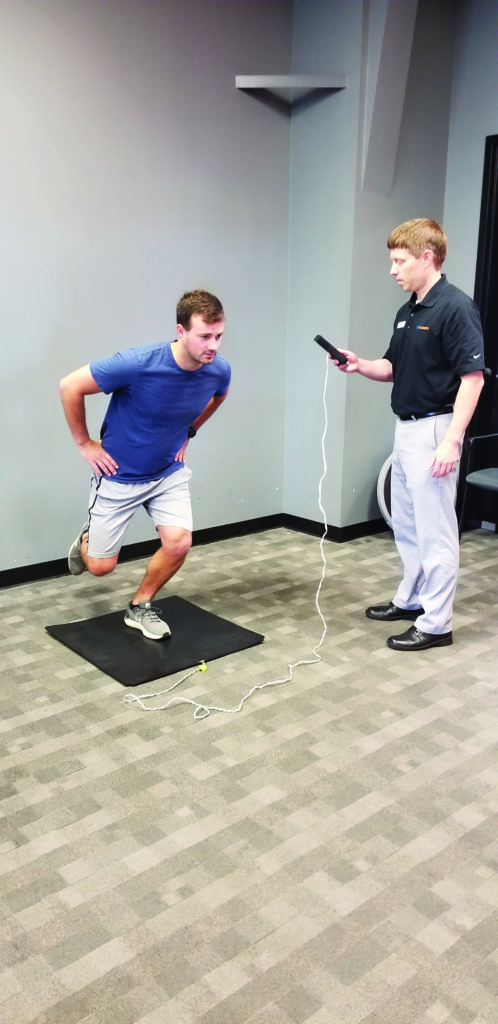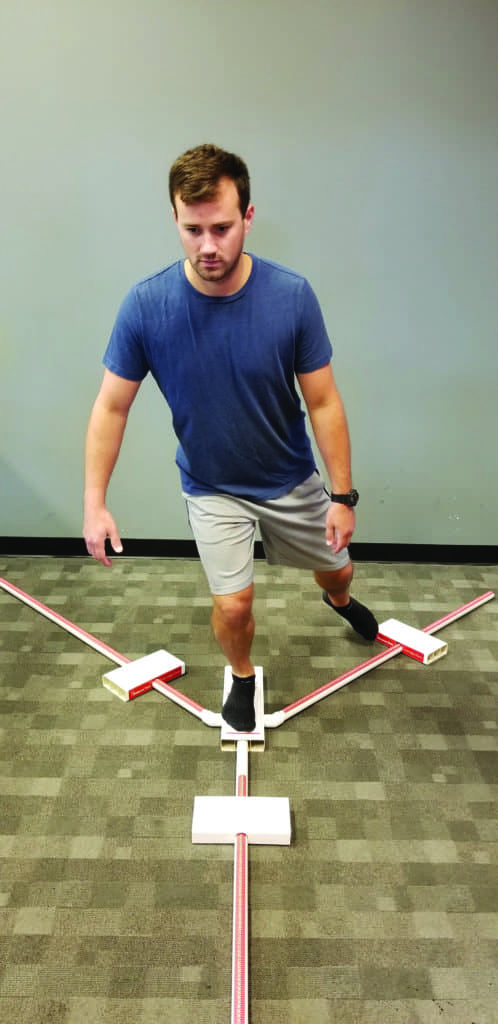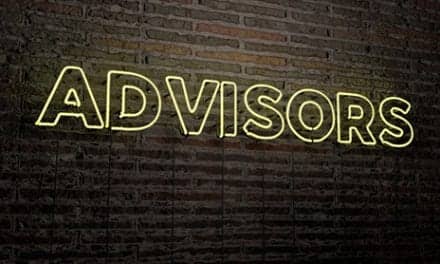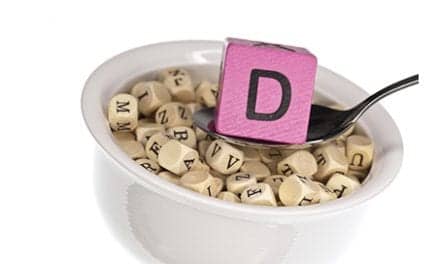CAPTION: Single-leg horizontal hop for distance- tests for both force production and force absorption abilities, with the goal of at least 90% symmetry side to side. Used commonly after ACL reconstruction but can be helpful for testing after hip and ankle injuries as well. Video analysis can be used to ensure proper landing mechanics.
By Chris Gabriel, PT, MPT, OCS, CSCS
As we see sports returning after a prolonged break, we will no doubt be seeing more injuries. Every year thousands of athletes suffer season- and often career-ending injuries. As they are carted off the field of play, they often give a thumbs-up sign to the fans, with a promise that they will be back, better than ever. As rehab professionals, we are often faced with the difficult balancing act of getting our athletes back on the field as quickly as possible while minimizing risk of reinjury.
The data for return to sport after an ACL reconstruction can be sobering. A systematic review with meta-analysis published in the British Journal of Sports Medicine reports that 35% of athletes do not return to their previous level of sport within 2 years after ACL reconstruction.1 The overall risk for a second ACL injury has been reported at 15%, with this number even higher for those under the age of 25 and athletes who return to high-level sport.2 Because of this, recent studies have suggested a considerable benefit for pushing out return to play to at least 9 months from time of surgery3; and many physicians are suggesting a year or more.
Trying to convince an athlete or a parent to wait a significantly longer time prior to getting back to play is a difficult task, regardless of injury risk data. Longer time away from competition can lead to lost scholarships and time isolated from peers and teammates, and have a significant financial impact for professionals. So we are left with the question of how fast we should expect athletes to return after ACL reconstruction. New surgical advances are being developed every day, but injuries will always be a part of sport. From a rehab standpoint, we strive to develop objective- and criterion-based protocols to determine when the athlete is ready to return to sport.


[sidebar float=”right” width=”250″]Product Resources
The following companies offer products that can be used for sports medicine programs of all types:
AlterG
www.alterg.com
Clarke Health Care Products
www.clarkehealthcare.com
First Degree Fitness (Fluid Power Zone)
www.fluidpowerzone.com
Fitter International Inc
www.fitter1.com
Magister Corp
www.magistercorp.com
Merrithew
www.merrithew.com
NZ Manufacturing Inc
www.nzcordz.com
OPTP
www.optp.com
Performance Health
www.performancehealth.com
Sissel USA
www.sisselshop.com
Stretchwell
www.stretchwell.com
The Hygenic Corp
www.theraband.com
VersaSlider
www.versaslider.com[/sidebar]
Tests Tell the Tale
It is easy to get caught up in looking at a calendar to determine when an athlete is ready to return to sport. Many studies suggest that this may still be the norm. We prefer to gather as much data as possible to determine when the athlete has recovered the necessary strength and motor control to handle the rigors of sport, not to mention full trust and confidence in their ability to perform.
Various technologies are available to assist therapists in this endeavor. I will discuss some of these today that are practical and available at a reasonable cost to assist in the decision-making process.
One of my favorite tools to employ is the Y balance test (functionalmovement.com). It involves the athlete standing on one leg and reaching into three directions as far as possible while maintaining contact with a block to assist in measuring the distance. We compare each leg side to side and look for symmetry, as well as take a composite score which references how good the reach distance is compared to the athlete’s leg length. Studies have shown the Y balance test is a reliable and valid tool that also has the ability to predict injury rates during a sports season.4 It is a great test to use early on in the rehab process to determine if the athlete is ready to move on to the next phase of rehab. It can be used on a wide range of clients with various diagnoses, and it is safe enough to be used on various age ranges.
Like any test, many will try to cheat to show improved performance. It is important to ensure the athlete maintains toe contact with the block at all times, and can return to the start position under control. I also like to watch for things like excessive valgus movement of the knee and early heel rise, and see how that compares to the uninjured side.
Safety Is Key
Hop testing has been around for some time, and is a great tool to use to determine symmetry side to side. A four-test battery of a single hop, triple hop, timed hop, and crossover hop has been researched extensively, and calculations lead to a limb symmetry index. Typically, 90% or greater is required for return to sport. In addition to the numerical scores on the hop test, it is important to make sure the athlete is using safe landing mechanics and has a symmetrical knee flexion angle and good control of valgus moment at the knee on both sides.5 Video analysis is helpful to assist in this area to provide a slow-motion, frame-by-frame view of the test to improve results. The use of advanced testing equipment such as a video camera that can capture higher fps such as 120+ can be very helpful to pick out subtle differences and also help the athlete understand where their deficits lie.
Smartphone apps such as Coaches Eye and Hudl Technique are readily available, and most phones and iPads these days can capture the higher frames per second needed. Force platforms are another valuable tool to assist in gaining data. One excellent measure is testing one leg vertical hop. I often find that an athlete is often able to pass standard hop testing, but still may be lacking in one leg vertical hop ability. The Just Jump System (Probotics, Huntsville, Ala) is a mobile and reasonably priced force platform that can gather data for one jump, four jumps, 60 jumps, sprint timer, and measure ground reaction time as well. It is important that we not just look at the height of the jump, but also ensure a soft landing with symmetrical flexion angle and good control of knee valgus bilaterally.
Tech Makes it Easier
If you are limited in terms of equipment available, there are more and more apps available that allow measurements to be taken from a video on your smartphone to determine jump height, distance, force production, etc. One of the more popular apps out there is the My Jump App (Carlos Balsalbre). Now updated to the My Jump 2, it allows the user to analyze slow-motion video captures to determine vertical jump height, horizontal jump distance, force-velocity profile, and a unilateral drop jump.
There is no perfect formula to determine when an athlete is ready to return to sport, but current literature does seem to support the need to extend the rehab process a little longer both to allow more time for graft healing as well as to return to higher levels of symmetry in functional testing. For some, a multi-million-dollar contract or college scholarship may be on the line, and the difference of another month or two may be considerably more consequential. Having clear objective criteria and goals can help athletes, parents, and coaches understand where the athlete is in the rehab process and what we need to improve upon prior to a safe return. If we must push for an early return, let’s use a strong battery of tests to ensure that our athletes are as ready as possible to handle what the rigors of competition will certainly dish out. This will allow us to return them to perform at higher levels, and hopefully reduce injury risk as well. PTP
Chris Gabriel, PT, MPT, OCS, CSCS, has more than 20 years of clinical experience and works for OrthoCarolina, based in Charlotte, NC. He is a Board Certified Clinical Specialist in Orthopaedic Physical Therapy through the APTA, and a Certified Strength and Conditioning Specialist through the NSCA. His clinical interests lie in late-stage ACL rehab as well as working with the overhead athlete. For more information, contact [email protected].
References
- Ardern CL, Taylor NF, Feller JA, Webster KE. Fifity-five per cent return to competitive sport following anterior cruciate ligament reconstruction surgery: an updated systematic review and meta-analysis including aspects of physical functioning and contextual factors. Br J Sports Med. 2014;48:1543-1552.
- Wiggins AJ, Grandhi RK, Schneider DF, Stanfield D, Webster KE, Myer GD. Risk of secondary injury in younger athletes after anterior cruciate ligament reconstruction: a systematic review and meta-analysis. Am J Sports Med. 2016;44:1861-1876.
- Grindem H, Snyder-Mackler L, Moksnes H, Engebretsen L, Risberg MA. Simple decision rules reduce reinjury risk after anterior cruciate ligament reconstruction: The Delaware-Oslo ACL cohort study. Br J Sports Med. July;50(13):804-808.
- Gonell AC, Romero JAP, Soler LM. Relationship between Y balance test scores and soft tissue injury incidence in a soccer team. Int J Sport Phys Ther. 2015;10(7):955-966.
- Kotsifaki A, Korakakis V, Whiteley R, Rossom SV, Jonkers I. Measuring only hop distance during single leg hop testing is insufficient to detect deficits in knee function after ACL reconstruction: as systematic review & meta-analysis. Br J Sports Med. 2019;0:1-16.
Related Content:
Study Looks at Return to Play for Soccer Athletes Following Revision ACL Reconstruction
Athlete Concussion: Orchestrating the Safe and Successful Return to Play
Biodex Software Now Includes Return-to-Play Report





